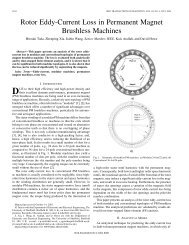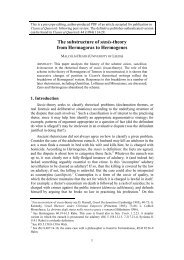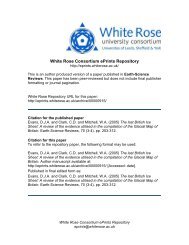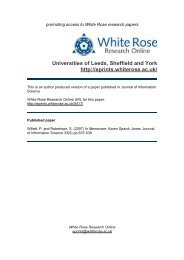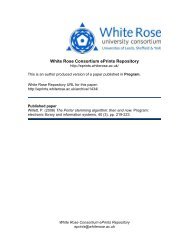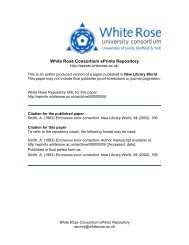The archaeological context of the Iwo Eleru cranium from Nigeria ...
The archaeological context of the Iwo Eleru cranium from Nigeria ...
The archaeological context of the Iwo Eleru cranium from Nigeria ...
Create successful ePaper yourself
Turn your PDF publications into a flip-book with our unique Google optimized e-Paper software.
distinctions between this population and <strong>the</strong> preceding one,<br />
so much so that <strong>the</strong>y are considered to be “biologically<br />
different” (Ribot et al., 2001: 192). Two adult female<br />
individuals at Shum Laka, SE III and SE IV, have an<br />
estimated stature <strong>of</strong> 153-155 and 143-148 cm respectively;<br />
this, it is considered, suggests “an affinity with Pygmy<br />
populations”, although <strong>the</strong>re is no supporting evidence to<br />
confirm this hypo<strong>the</strong>sis (Ribot et al., 2001: 176).<br />
Gobero is a site complex in central Niger, which was<br />
discovered in 2000 and excavated in 2005-2006; not<br />
surprisingly, it has attracted a good deal <strong>of</strong> attention<br />
(Sereno et al., 2008; Gwin, 2008). It is located on <strong>the</strong><br />
north-western rim <strong>of</strong> <strong>the</strong> Chad basin, about 150 km sou<strong>the</strong>ast<br />
<strong>of</strong> <strong>the</strong> Aïr massif. At <strong>the</strong> beginning <strong>of</strong> <strong>the</strong> Holocene a<br />
shallow freshwater lake formed here, pooled against a low<br />
east-west fault scarp, and, with an interruption, this lake<br />
continued in existence for some 5000 years. Both lake<br />
episodes were associated with human occupation, traces<br />
<strong>of</strong> which are now preserved in three main palaeodune<br />
deposits (Sereno et al., 2008, Fig. 1). A minimum <strong>of</strong> 182<br />
human burials have been noted, <strong>of</strong> which 67 have been<br />
excavated. 78 radiocarbon dates have been obtained<br />
and 9 OSL dates on palaeodune sand. On this basis, <strong>the</strong><br />
excavators have divided <strong>the</strong> sequence into four principal<br />
phases (Sereno et al., 2008, Fig. 3). Phase 2 represents<br />
<strong>the</strong> early Holocene occupation, which has been dated in<br />
<strong>the</strong> range <strong>from</strong> 8640±40 to 7390±40 BP. <strong>The</strong> artefacts<br />
(including bone harpoons and ceramics) are characteristic<br />
<strong>of</strong> <strong>the</strong> Kiffian techno-complex. <strong>The</strong> analysis conducted<br />
by Sereno and his colleagues suggests that <strong>the</strong> population<br />
represented here is similar to <strong>the</strong> “Mechtoids” described<br />
<strong>from</strong> North Africa and <strong>the</strong> Sahara. Phase 3 is assigned to<br />
<strong>the</strong> mid-Holocene and has dates in <strong>the</strong> range <strong>from</strong> 5940±40<br />
to 4090±40 BP. <strong>The</strong> artefacts (including hollow-based<br />
projectile points and pottery) belong to <strong>the</strong> Tenerean technocomplex.<br />
No particular affinities have been suggested for<br />
this “morphologically isolated” human group (Sereno et<br />
al., 2008, Fig. 6), but it is considered unlikely that <strong>the</strong>y<br />
evolved in situ <strong>from</strong> <strong>the</strong> preceding population.<br />
<strong>The</strong>se studies clearly show that <strong>the</strong> population <strong>of</strong> this area<br />
in <strong>the</strong> early and mid Holocene was not homogeneous. But<br />
so far, <strong>Iwo</strong> <strong>Eleru</strong> retains its status as <strong>the</strong> earliest known<br />
excavated burial in <strong>the</strong> region.<br />
<strong>The</strong> wider <strong>context</strong><br />
So far, <strong>the</strong>re is no o<strong>the</strong>r Pleistocene LSA succession<br />
in West Africa comparable to Shum Laka. As already<br />
remarked, pottery came into use at that site at about <strong>the</strong><br />
same time as at <strong>Iwo</strong> <strong>Eleru</strong>. At Ounjougou, in Mali, <strong>the</strong>re<br />
is a radiocarbon date <strong>of</strong> 8700±75 BP directly associated<br />
with pottery at Ravin du Hibou (Huysecom et al., 2004a,<br />
2004b; Raeli and Huysecom, 2004). <strong>The</strong> assemblage here<br />
is described as Kiffian, and in terms <strong>of</strong> dating this obviously<br />
is consonant with <strong>the</strong> evidence <strong>from</strong> Gobero. In 2007 a<br />
few more sherds were found in a stratigraphically lower<br />
horizon at Ravin de la Mouche, so <strong>the</strong> advent <strong>of</strong> pottery at<br />
this site may be even earlier (Huysecom et al., 2009, Fig. 1<br />
and Table 1). As a whole <strong>the</strong>refore <strong>the</strong> evidence still seems<br />
<strong>the</strong> ArchAeologicAl <strong>context</strong> <strong>of</strong> <strong>the</strong> iWo eleru crAnium <strong>from</strong> nigeriA<br />
37<br />
to support Shaw’s view that <strong>the</strong> advent <strong>of</strong> pottery in West<br />
Africa was due to diffusion <strong>from</strong> <strong>the</strong> north. Ounjougou is<br />
important for an entirely different reason, since, as reported<br />
at this conference by Sylvain Soriano (see also Rasse et al.,<br />
2004), it has produced for <strong>the</strong> first time a reliably dated<br />
West African Pleistocene sequence for <strong>the</strong> MSA, dated by<br />
OSL to a period <strong>from</strong> about 160 to 19 kyrs BP. <strong>The</strong>re<br />
are also two OSL dates <strong>of</strong> 40.8±11.4 and 23.6±9 kyrs BP<br />
<strong>from</strong> Birimi in nor<strong>the</strong>rn Ghana for a “flake industry with<br />
a strong Levallois component” (Casey, 2003; Quickert et<br />
al., 2003). <strong>The</strong>re are still no hominid associations with <strong>the</strong><br />
MSA in West Africa, but if <strong>the</strong> younger <strong>of</strong> <strong>the</strong> dates at <strong>the</strong>se<br />
two sites are correct <strong>the</strong>n <strong>the</strong> makers <strong>of</strong> <strong>the</strong>se industries<br />
(whoever <strong>the</strong>y were) will have lived (presumably) side by<br />
side with <strong>the</strong> makers <strong>of</strong> <strong>the</strong> LSA.<br />
<strong>The</strong> main characteristics and <strong>the</strong> chronology <strong>of</strong> <strong>the</strong> late<br />
Pleistocene and <strong>the</strong> early Holocene in West Africa and<br />
<strong>the</strong> Sahara have been clearly delineated in recent studies,<br />
which broadly speaking do confirm <strong>the</strong> model which<br />
Shaw employed at <strong>the</strong> time <strong>the</strong> <strong>Iwo</strong> <strong>Eleru</strong> report was<br />
written. DeMenocal and his colleagues have established<br />
a framework for <strong>the</strong> nature and longevity <strong>of</strong> <strong>the</strong> African<br />
Humid Period, which followed <strong>the</strong> end <strong>of</strong> <strong>the</strong> Pleistocene,<br />
on <strong>the</strong> basis <strong>of</strong> <strong>the</strong> marine core at ODP site 658C <strong>of</strong>f Cap<br />
Blanc, Mauritania (DeMenocal et al., 2000, Figs. 2, 3, and<br />
4). Humid conditions initially commenced at about 14.8<br />
cal kyrs BP, with <strong>the</strong> main episode <strong>of</strong> <strong>the</strong> AHP occurring<br />
between about 9 and 5.5 cal kyrs BP. It is likely that during<br />
<strong>the</strong> Late Glacial Maximum <strong>the</strong> sou<strong>the</strong>rn boundary <strong>of</strong> <strong>the</strong><br />
Sahara may have been situated at about 14°N, whereas<br />
in <strong>the</strong> early Holocene <strong>the</strong> nor<strong>the</strong>rn boundary <strong>of</strong> <strong>the</strong> forest<br />
may have reached as far as 10-12°N (Dupont et al., 2000).<br />
Lézine and Cazet (2005, Fig. 5) have proposed a stepwise<br />
model for <strong>the</strong> northward expansion <strong>of</strong> <strong>the</strong> forest in<br />
West Africa during <strong>the</strong> AHP, extending <strong>from</strong> about 11.6<br />
to 9.3 cal kyrs BP. <strong>The</strong>re was a similarly uneven retreat at<br />
<strong>the</strong> end <strong>of</strong> <strong>the</strong> period. <strong>The</strong>re is some disagreement about<br />
<strong>the</strong> extent to which <strong>the</strong> forest was reduced to fragments<br />
along <strong>the</strong> coast during <strong>the</strong> LGM, but <strong>the</strong> principle <strong>of</strong> its<br />
expansion is not in doubt. Any discrepancy between <strong>the</strong>se<br />
authors is unlikely to upset Thurstan Shaw’s idea that <strong>the</strong><br />
occupation <strong>of</strong> <strong>Iwo</strong> <strong>Eleru</strong> began in savanna conditions and<br />
persisted in a forested environment. <strong>The</strong> advance <strong>of</strong> <strong>the</strong><br />
forest in <strong>the</strong> AHP was mirrored by a rise in lake levels,<br />
most notably Lake Chad (Leblanc et al., 2006). <strong>The</strong> lake<br />
may have begun to fill as far back as 10,160±160 BP and<br />
may not finally have begun to retreat until 3000±110<br />
BP. It is estimated that it will have been at its maximum<br />
extent between about 7700 and 5500 BP, corresponding to<br />
about 8.5 to 6.3 cal kyrs BP. Lake Mega Chad <strong>the</strong>refore<br />
constitutes one <strong>of</strong> <strong>the</strong> most dramatic evidences for an early<br />
Holocene climatic optimum and its eventual decline to<br />
conditions more resembling those <strong>of</strong> <strong>the</strong> present.<br />
Studies <strong>of</strong> <strong>the</strong> <strong>Iwo</strong> <strong>Eleru</strong> <strong>cranium</strong><br />
<strong>The</strong> poorly preserved skeleton was <strong>of</strong> an adult and<br />
probably male individual, and <strong>the</strong> skull was reconstructed<br />
and studied by Brothwell (Brothwell and Shaw, 1971). He




